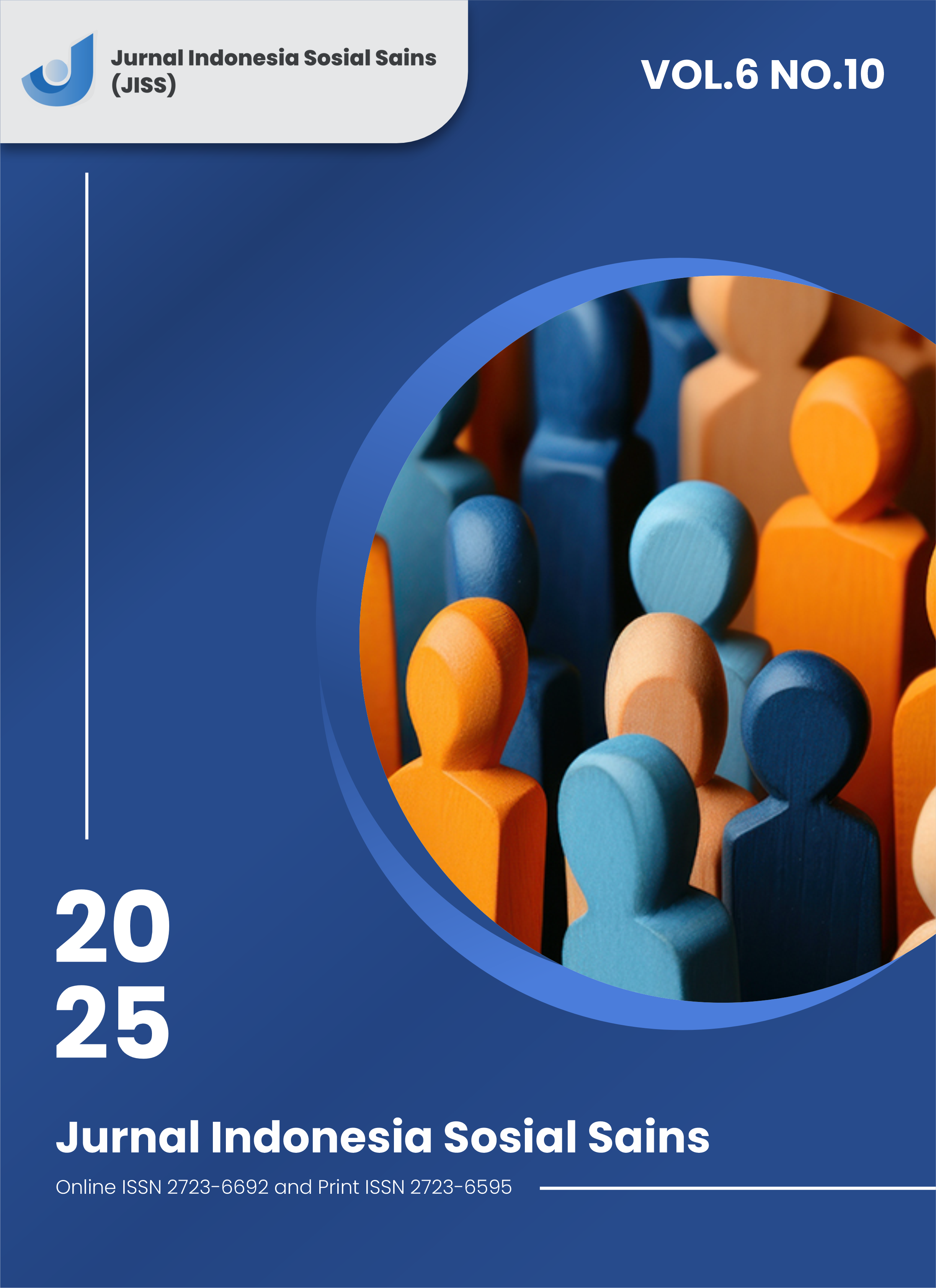The Relationship Between Parental Smartphone Use Duration and the Incidence of Stunting in Children in Medan City
DOI:
https://doi.org/10.59141/jiss.v6i10.2025Keywords:
stunting, smartphone, addiction, parenting, case controlAbstract
Stunting remains a major public health problem in Indonesia, with multidimensional impacts ranging from impaired physical growth to reduced human capital quality. Socioeconomic status, parental education, and parenting practices are recognized determinants, but the role of digital behavior, particularly smartphone use, remains underexplored. This study aims to analyze the association between parental smartphone use duration and stunting among children in Medan City. An analytical observational study with a case-control design was conducted involving 124 respondents (62 cases, 62 controls) selected through purposive sampling. Data were collected using sociodemographic questionnaires and the Smartphone Addiction Scale – Short Version (SAS-SV). Statistical analysis employed Chi-Square tests and Odds Ratio estimation. Most case respondents had a high school education (51.6%) and a family income of IDR 1,000,000–3,000,000 (64.5%), while control respondents were predominantly university graduates (88.7%) with incomes exceeding IDR 5,000,000 (54.8%). Smartphone addiction was more prevalent in the case group (71.0%) than in controls (21.0%). A significant association was found (p < 0.001), with OR = 9.214 (95% CI: 4.053–20.948). Excessive parental smartphone use is significantly associated with stunting in children, highlighting the need for preventive interventions that address digital behavior as an emerging risk factor.
References
Andrade, A. L. M., Scatena, A., Martins, G. D. G., de Oliveira Pinheiro, B., da Silva, A. B., Enes, C. C., de Oliveira, W. A., & Kim, D.-J. (2020). Validation of smartphone addiction scale–short version (SAS-SV) in Brazilian adolescents. Addictive Behaviors, 110, 106540. https://doi.org/10.1016/j.addbeh.2020.106540
Anggraini, Y., & Romadona, N. F. (2020). Review of Stunting in Indonesia. International Conference on Early Childhood Education and Parenting 2019 (ECEP 2019), 281–284.
Anwar, S., Winarti, E., & Sunardi, S. (2022). Systematic review faktor risiko, penyebab dan dampak stunting pada anak. Jurnal Ilmu Kesehatan, 11(1), 88–94. https://doi.org/10.36590/jika.v11i1.218
Basit, A., Purwanto, E., Kristian, A., Pratiwi, D. I., Mardiana, I., & Saputri, G. W. (2022). Teknologi komunikasi smartphone pada interaksi sosial. LONTAR: Jurnal Ilmu Komunikasi, 10(1), 1–12. https://doi.org/10.30656/lontar.v10i1.3815
Hutabarat, E. N. (2022). Permasalahan stunting dan pencegahannya. Journal of Health and Medical Science, 5(2), 158–163.
Laily, L. A., & Indarjo, S. (2023). Literature review: Dampak stunting terhadap pertumbuhan dan perkembangan anak. HIGEIA (Journal of Public Health Research and Development), 7(3), 354–364. https://doi.org/10.15294/higeia.v7i3.72758
Lestari, D. I. (2022). Hubungan adiksi smartphone dengan empati pada siswa kelas VIII di MTs Negeri 3 Bojonegoro.
Melumad, S., & Pham, M. T. (2020). The smartphone as a pacifying technology. Journal of Consumer Research, 47(2), 237–255. https://doi.org/10.1093/jcr/ucaa005
Nurcahyanti, K. K. A., & Rahmansyah, I. (2023). Efektivitas pemanfaatan stunting mobile untuk pencegahan stunting dengan meningkatkan pemahaman kebutuhan asupan makan di Kabupaten Banyumas. Jurnal Multidisiplin Indonesia, 2(4), 594–599.
Oktavia, R. (2021). Hubungan faktor sosial ekonomi keluarga dengan kejadian stunting. Jurnal Medika Hutama, 3(2), 1616–1620.
Retalia, R., Soesilo, T. D., & Irawan, S. (2022). Pengaruh penggunaan smartphone terhadap interaksi sosial remaja. Scholaria: Jurnal Pendidikan Dan Kebudayaan, 12(2), 139–149.
Rusliani, N., Hidayani, W. R., & Sulistyoningsih, H. (2022). Literature Review: Faktor-faktor yang berhubungan dengan kejadian stunting pada balita. Buletin Ilmu Kebidanan Dan Keperawatan, 1(1), 32–40.
Sandy, S. S. (2021). Hubungan antara smartphone addiction dengan nomophobia pada mahasiswa Fakultas Psikologi Universitas Islam Riau.
Saputri, A., Usman, U., & Rusman, A. D. P. (2022). Analisis sosial ekonomi dengan kejadian stunting di daerah dataran tinggi Kota Parepare. Jurnal Ilmiah Manusia Dan Kesehatan, 5(3), 503–510.
Sinabang, P. B. (2023). Gaya hidup sedentari, screen time, pola makan, dan aktivitas fisik terhadap status gizi siswa kelas X di SMKN 2 Rantau Utara.
Solihin, Y. S., Sari, C. W. M., Shalahuddin, I., Rahayuwati, L., & Eriyani, T. (2024). Tingkat pendidikan, pendapatan, dan pola asuh orang tua terhadap kejadian stunting pada balita. Journal of Telenursing (Joting), 6(1), 34–42.
Sugianto, M. A. (2021). Analisis kebijakan pencegahan dan penanggulangan stunting di Indonesia: Dengan pendekatan what is the problem represented to be? Jurnal Ekonomi, Manajemen, Bisnis, Dan Sosial (EMBISS), 1(2), 197–209.
Vik, F. N., Grasaas, E., Polspoel, M. E. M., Røed, M., Hillesund, E. R., & Øverby, N. C. (2021). Parental phone use during mealtimes with toddlers and the associations with feeding practices and shared family meals: A cross-sectional study. BMC Public Health, 21(1), 1–8. https://doi.org/10.1186/s12889-021-11156-9
Wahyudi, M. F. (2022). Pengaruh adiksi smartphone terhadap perilaku phubbing Karang Taruna Desa Sukorejo Kecamatan Bangorejo.
Yuana, N., Larasati, T., & Berawi, K. N. (2021). Analisis multilevel faktor risiko stunting di Indonesia: Sebuah tinjauan literatur. Jurnal Aisyah: Jurnal Ilmu Kesehatan, 6(2), 213–217.
Yusuf, K. (2020). Hubungan pola makan dan pengetahuan ibu dengan kejadian status gizi kurang di SDN 22 Maros Kec. Maros Baru Kab. Maros tahun 2019. Jurnal Berita Kesehatan, 13(1), 45–52.
Downloads
Published
How to Cite
Issue
Section
License
Copyright (c) 2025 Kevin Wutama, Irza Haicha Pratama, Qori Fadillah, Indira Ade Mastura

This work is licensed under a Creative Commons Attribution-ShareAlike 4.0 International License.
Authors who publish with this journal agree to the following terms:
- Authors retain copyright and grant the journal right of first publication with the work simultaneously licensed under a Creative Commons Attribution-ShareAlike 4.0 International. that allows others to share the work with an acknowledgement of the work's authorship and initial publication in this journal.
- Authors are able to enter into separate, additional contractual arrangements for the non-exclusive distribution of the journal's published version of the work (e.g., post it to an institutional repository or publish it in a book), with an acknowledgement of its initial publication in this journal.
- Authors are permitted and encouraged to post their work online (e.g., in institutional repositories or on their website) prior to and during the submission process, as it can lead to productive exchanges, as well as earlier and greater citation of published work.












